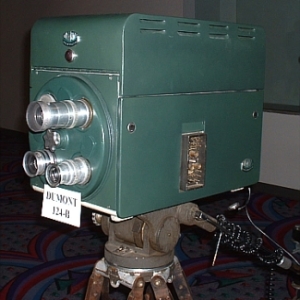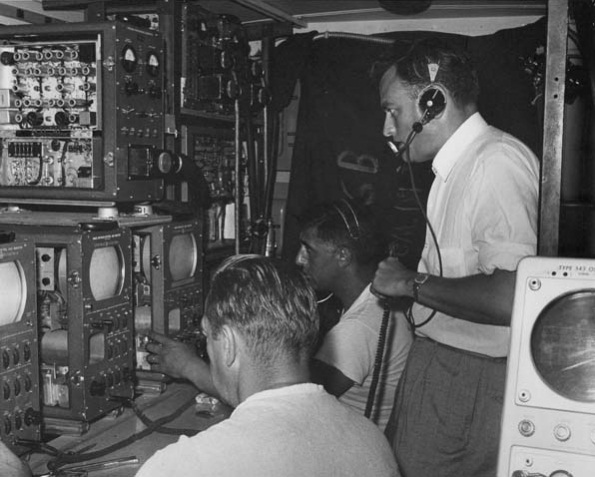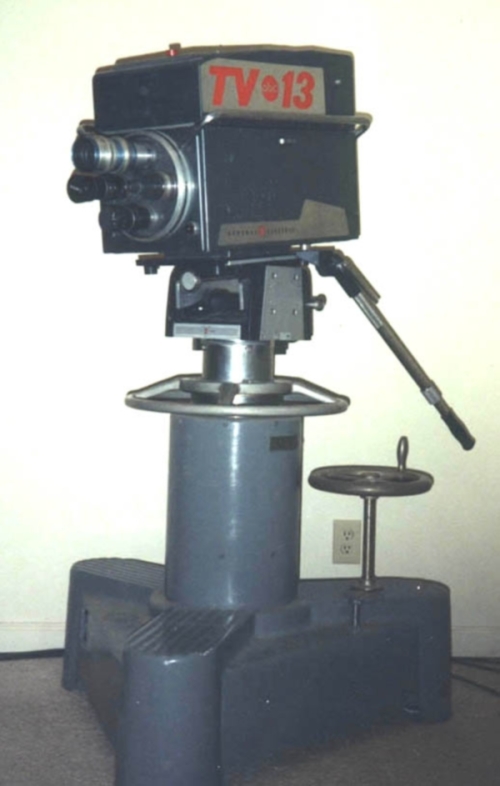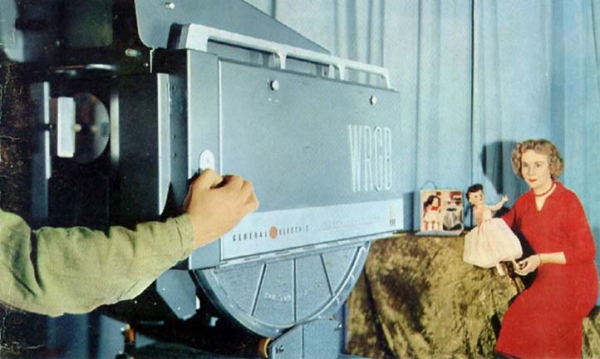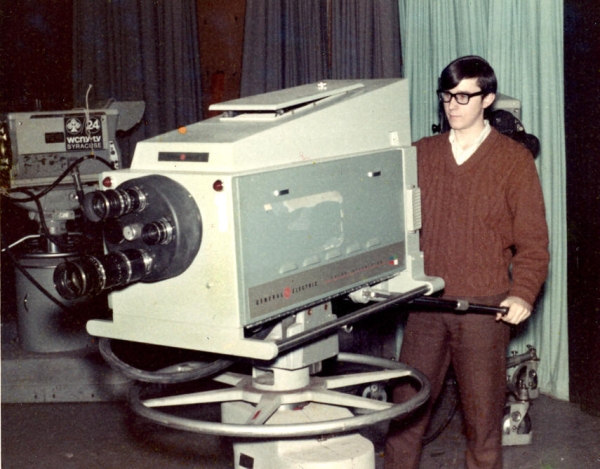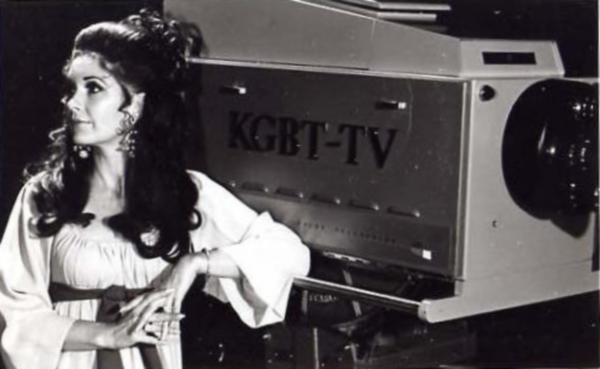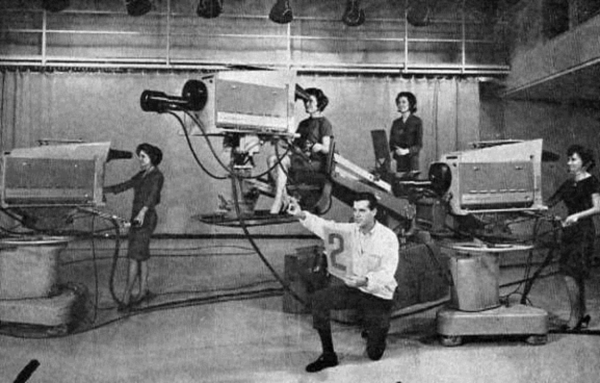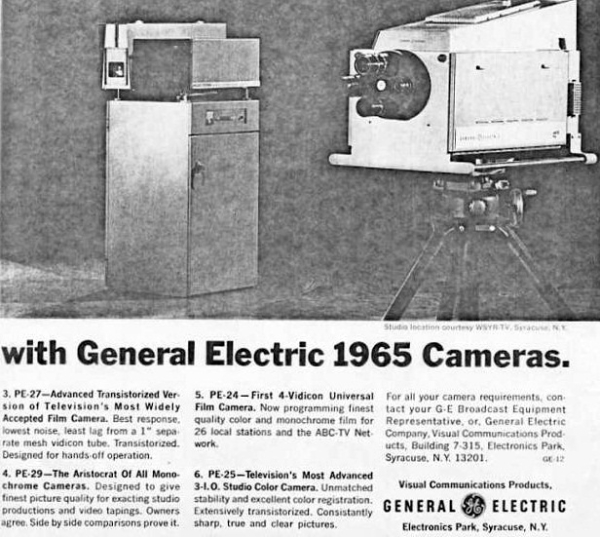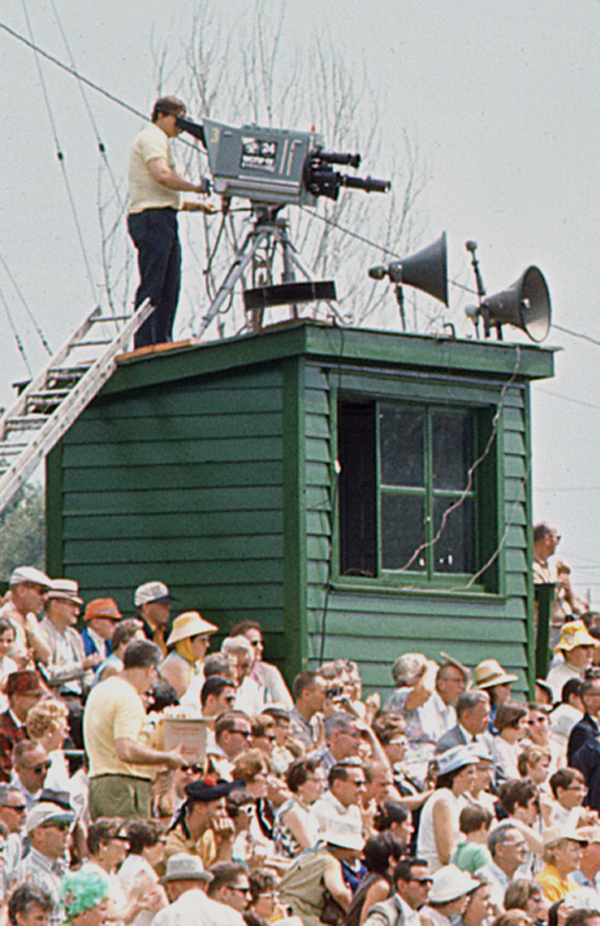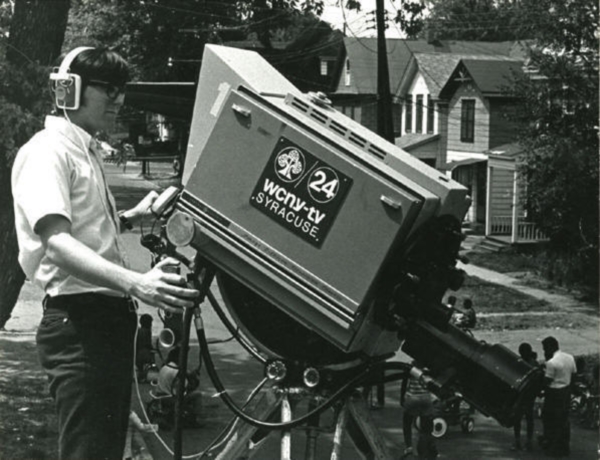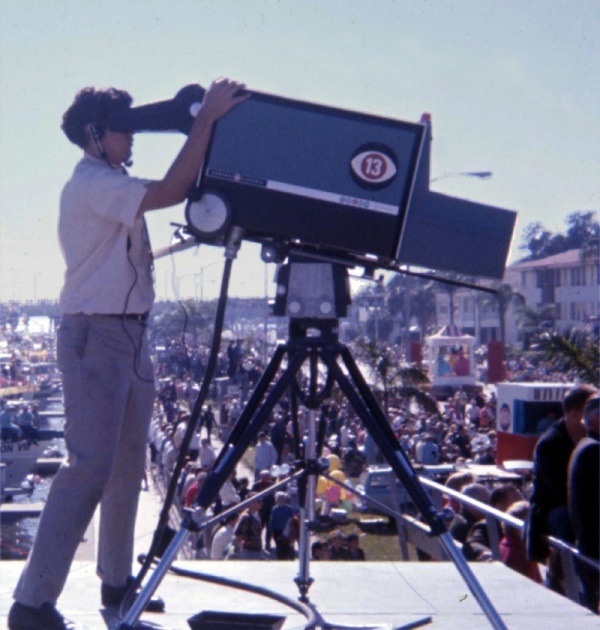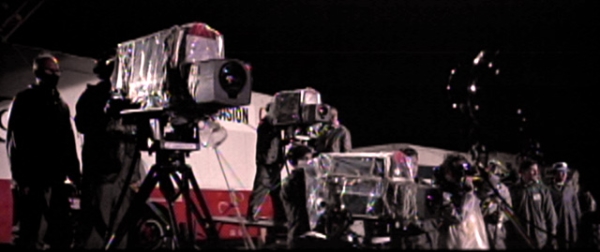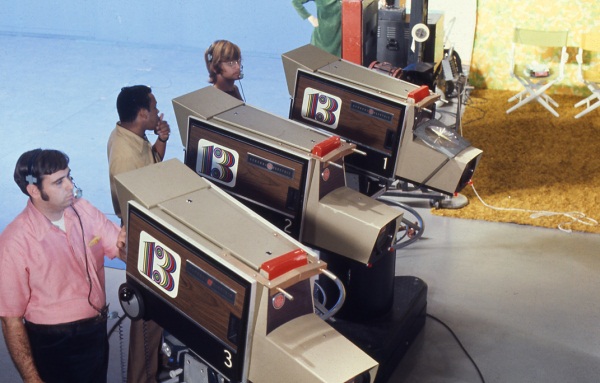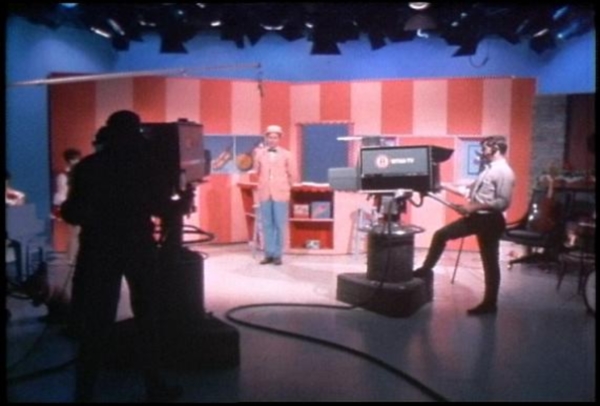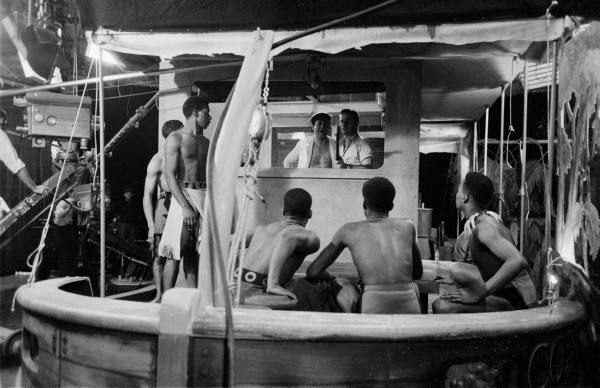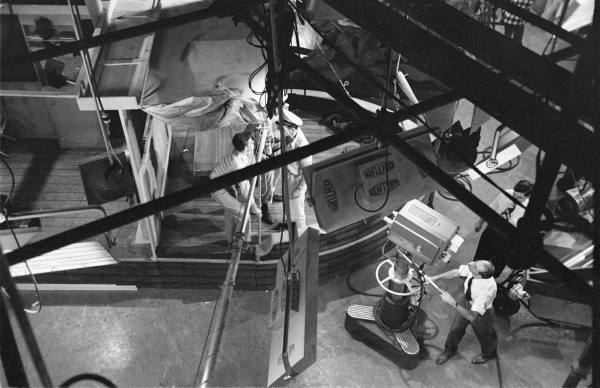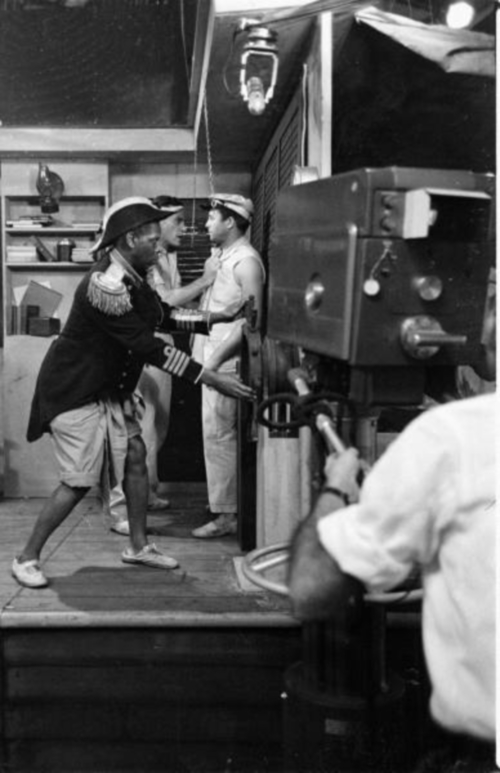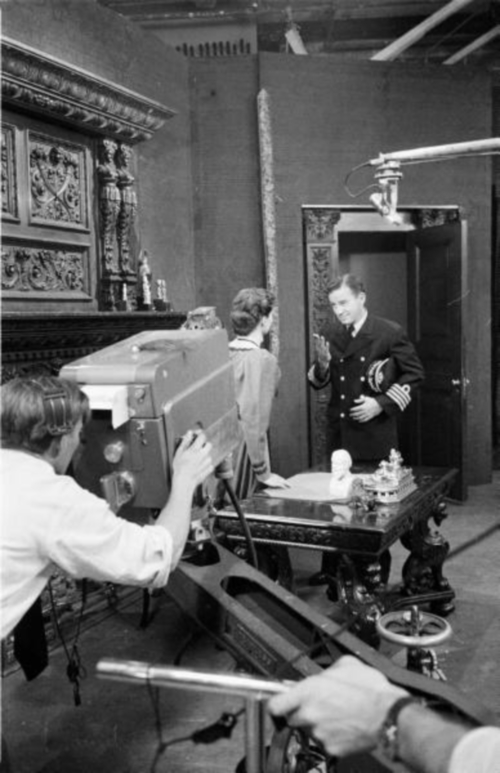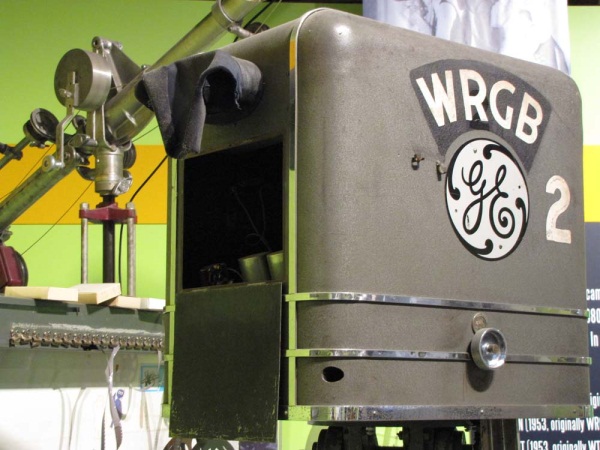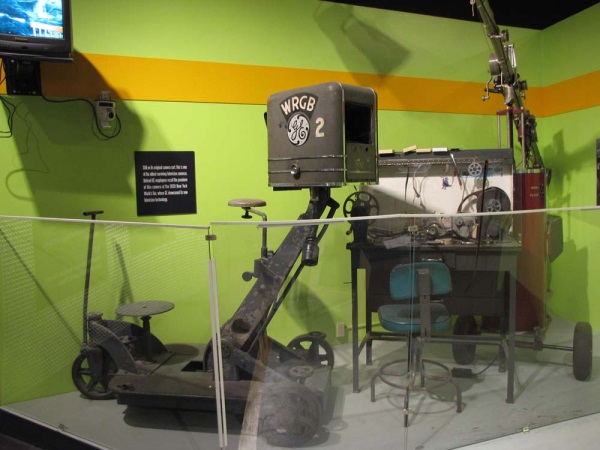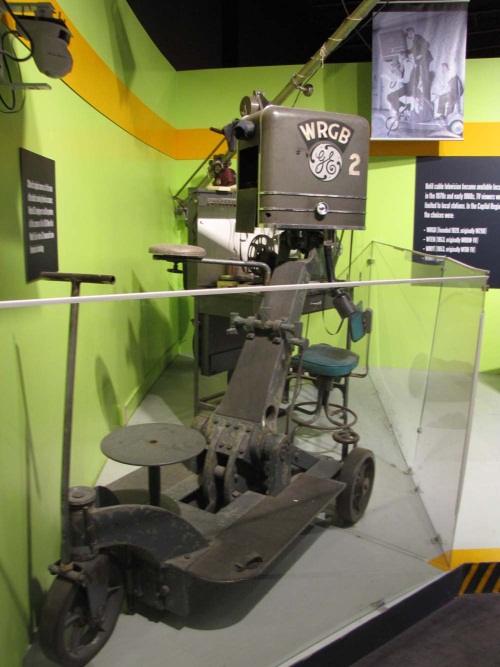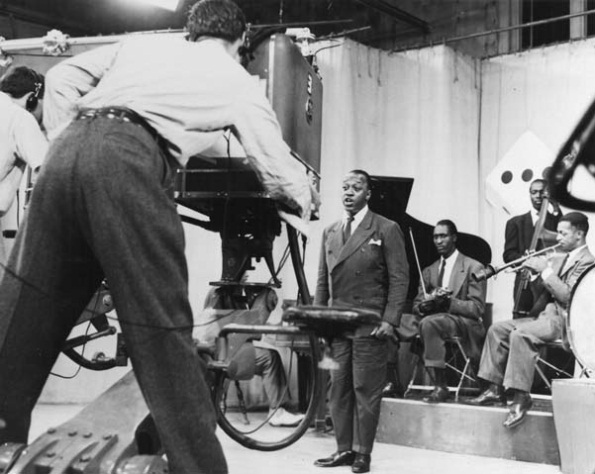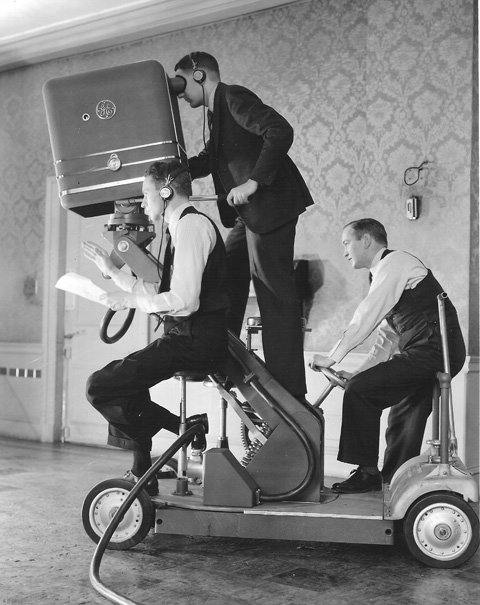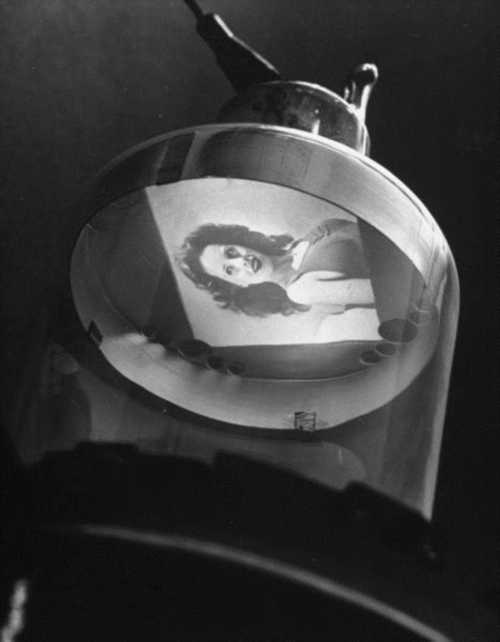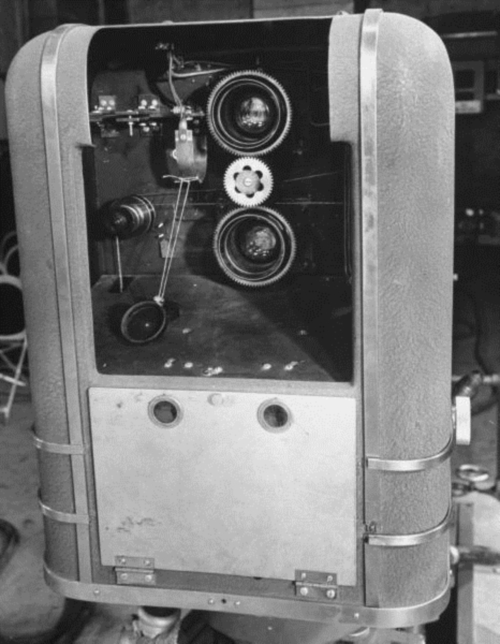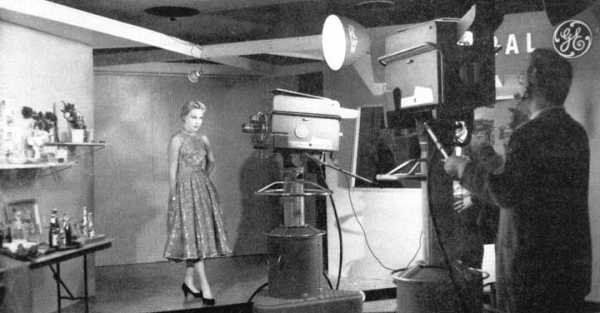Not long ago, I received some GE catalogs from Randy Blakeney in Laurel, MS. In researching the GE material I have discovered two important facts about the GE television cameras.
First Discovery: I have found definitive details in regard to the proper GE model designations of the PC and PE cameras.
Unlike the RCA TK prefix on all their cameras, GE had the PC and PE prefixes and this has caused a lot of confusion about what is a PC and a PE camera from GE. Close study of the GE catalogue from 1965 has led me to a conclusion that I will share with you below and illustrate with an image.
Above, left is a GE PC 11 and right is a GE PE 23. This photo is possibly from WAAY, channel 31 in Huntsville, Alabama but it’s a very interesting photo none the less for reasons I will discuss below. The left camera is a GE PC 11, 3″ Image Orthicon camera. The camera on the right is also a 3″ IO camera and is the 1965 GE PE 23.
Prior to the PE 23, the GE catalog refers to their new or modified camera control chains with a PE prefix and then a model number, and then lists their existing cameras that will work with that new chain using a PC prefix for the camera models. For instance, the PE 28 chain worked with the PC 12 IO camera, but something happened along the way and GE started giving their cameras the PE prefix too. (Oh, the humanity!)
Here’s the change…the PE 23 camera is described in their catalogue as “the first totally transistorized” studio camera and chain. My conclusion is that starting with the PE 23 camera in 1965, all the new GE cameras were solid state, transistorized cameras with no tubes (other than the imaging tubes) and were from then on identified with the PE prefix…that means that all GE cameras with the PC prefix had tubes, and/or were built before 1965.
Second Discovery: the early GE cameras were actually manufactured for GE by Dumont in the early years.
It is pretty obvious that their cameras bear a striking resemblance, especially when you look at the same small viewfinder and cable connections on some of these cameras on this page and on the Dumont page. Ed Reitan has verified this bit of history, but neither of us yet have any details or documentation. Even Bruce DuMont in Chicago does not know the details. Unfortunately, GE broadcast equipment history is sketchy at best as the brand was not that widely used. For some reason, GE camera use was concentrated in Texas and the southwest, although Syracuse NY is where they built the GE cameras.
Above left is a GE badged camera (model unknown) at KRLD that is almost identical to the Dumont 124B in the Chuck Pharis collection.
Above, we see the WRGB remote truck with two of these Dumont made cameras on top and below, we’re inside the van sweating it out with the boys in Albany, New York.
This mint condition PC 11A camera now belongs to my friend Steve McVoy and is on display at his Early Television Museum in Hilliard Ohio.
Photo courtesy earlytelevision.org.
This KRLD camera is believed to also be a PC 11, but a later model with a flat top. It could be a PC 11B or C. If you have any old GE catalogs, please contact me because there are very few resources to research these cameras.
In the two images above and the two below we see The GE Beast! The top image at WRGB is the GE PC 15 circa 1958. Notice the handles are on top of the camera body. Just above is the GE PE 25 color camera that came out in ’65, and the top handles are now bottom bar handles. This camera is at WCNY, Syracuse, NY and is being operated by Mike Clark.
This 3 image orthicon creation resembles the RCA TK41 in looks and mass, but weighs in at ”only’ 215 pounds compared to the TK42’s 280 pounds and the TK41’s 350 pounds. I did not know this, but WRGB in Albany, NY claims to be the world’s first television station. It traces its roots to an experimental station founded on January 13, 1928 by General Electric under the call letters W2XB on channel 4.
Below is a PE 25 from KGBT in Harlingen, Texas. The bottom image is thought to be part of a GE magazine ad. Although GE broadcast equipment was built in Syracuse NY, in general it seems the west and south were their best broadcast markets. In a discussion with Pete Fasciano (inventor of the Avid editing system), Pete recalled that GE was so far behind in sales that had the plumbicon tube not come along when it did, GE may well have gotten out of the broadcast business because without them, they would not have had the 250s, 350s and 400s.
All photos are courtesy of Mike Clark.
I have referred to the GE color camera as the PE 15 but later versions of the camera were labeled as the PE 25 as can be seen in the information above. On top is a GE catalog image from the late 50s calling it a PE 15, and on the bottom, a 1965 GE add describing it at the PE 25.
Here is a newly found GE brochure on the PE 25 from our friend Martin Perry.
Above is the GE PC 12 I/O camera on November 24, 1963 at the Dallas police headquarters and in the foreground is Lee Harvey Oswald the day before being shot by Jack Ruby. This same camera, or one of the 3 KRLD PC12s that were there that day, is now in the collection of my friend Chuck Conrad who has the Chalk Hill Media site listed in our links. In another interesting link to the Kennedy assassination, Chuck has the WFAA remote bus, a Dumont Telecruiser that was then equipped with Marconi Mark IV cameras. In the Marconi section, you can see one of the WFAA cameras at the Dallas police HQ, again, just moments before Oswald was shot.
Here are two great shots of the PC 12 at work. Above and below are from WCNY, PBS in Syracuse which is where these cameras were made. Thanks to Mike Clark (shown below) for these photos. Notice how young Mike is in this and the PC15 shot above…still in high school. I can relate to his early entrance to TV. I started visiting the local radio station at age 14 and have been fortunate enough to be heard on radio or TV almost continuously for 45 years.
Around 1966, GE updated the PC 12 to the PE 28 (3″ IO) and PE 29 (4 1/2″ IO) and thanks again to Martin Perry, here is that intro brochure.
Above is the GE PE 250 at WTVT Tampa around 1968…when GE dropped the PE 25, the PE 250 was the next new color camera. The 3 photos below also show their GE cameras at work on the set of Sony Pictures “Marooned” movie shot at Cape Canaveral. (I know it’s Kennedy now, but my generation first knew it as Cape Canaveral.) In the first shot of the photos below, notice there are 2 blue Norelcos, a grey Norelco, 2 of the GE cameras and even 2 RCA TK10s or 11s. Can you find them all? The 2 oblong photos below that are WTVT’s 350s.
Photos courtesy of Mike Clark, big13.net and Sony Pictures.
One final shot from the Big 13 showing their GE PE 400s shooting a Publix spot. Gotta’ love the faux wood grain side panels.
The following 6 pictures pictures courtesy of Martin Perry
GE PE-250 KOSA-TV Odessa, TX 1970 (The Admiral Foghorn Show)
GE PE-350’s WFAA-TV, Dallas Circa 1969 (Peppermint Place)
GE PE-400 CBS NFL Football (Used KDFW Remote Truck) Texas Stadium Cowboys vs Bears 1976?
GE PE-350’s on Vinten 419 Peds WFAA-TV Studio C 1980
GE PE-350 on Vinten 419 Ped WFAA-TV Studio A 1980
GE PE-250 from the Martin Perry collection
These 10 pictures are from a 1950 dress rehearsal of a Ford sponsored drama set in Africa. The cameras have finally been identified as GE PC-7A models and were probably made by Dumont for GE. This is a major production and the sets and camera positioning are really just amazing. With no camera art or identifying logos anywhere, it’s impossible to tell who is doing this, but my research leads me to believe it was an ABC production.
Every major city had its own version of Miami’s Skipper Chuck Show. Here he is in the 1950s at WTVJ. My old alma mater…I was the voice of the station for several years in the 1985-90 period.
Early GE Cameras at WRGB
Let’s start in the present and work our way back to the 1940s, shall we? What you see below is one of two surviving GE Iconoscope cameras from WRGB-TV that are in the loving care of the Schenectady Museum, which is a major repository of GE and WRGB archives. Many thanks to the Museum and it’s archivist, Chris Hunter, for his help and the images below.
The camera is mounted on its 1930 style ‘trolley’…a three-wheel forerunner to the four-wheel studio dolly.
As we transition from today to yesterday, we see the final today shot of what may well have been the 1947 cameraman’s mount below. It seems that WRGB had three cameras with mounted on this three wheel ‘trolley’, a four wheel Houston Fearless Panoram dolly and one of the old style peds that also housed some camera control units. By the way…take a close look at the man singing. I wonder if this is Rev. Al Sharpton’s father? Really.
Now this is real history. The date is September 11, 1928 and you are seeing the very first television drama ever to air. This performance of ‘The Queen’s Messenger’ was shown on the experimental TV system and simulcast on WGY radio. The director of the program was Mortimer Stewart and one of the actresses was a retired Broadway star actress, Izetta Jewel Miller. WRGB was started by GE as an experimental station in early 1928 and claims to be the oldest TV station in the country.
Over time, the cameras changed a little with the metal GE badge shown above, removed and replaced with the large GE logo and the WRGB call letters added as seen below. The call letter were originally W2XB in the experimental days, but changed in 1948. WRGB would have been a great name for the first color station with the red, green and blue referral, but the RGB is for Walter R. G. Baker who was a very senior GE engineer and head of the NTSC.
In the three images above, you see WRGB cameras mounted on the 790 pound PD-1-A HF Panoram dolly. This was an item in the 1951 GE catalog along with a very interesting pedestal. You can see several GE catalogs from the ’40s and ’50s in the Archives section, courtesy of the Schenectady Museum.
Circa 1947, an unidentified production is underway with GE Iconoscope cameras at WRGB in Albany, NY. Note the awkward pedestal design. This can be seen better in the picture below in the shot from the control room.
Photo courtesy Life Magazine
Rear shots of one of the GE Iconoscope cameras shown in the studio shots above. Notice that you can see the rear of the Iconoscope tube. Below is an incredible photo of an image focused inside that tube.
Photo courtesy Life Magazine
This is the front of the 1943 GE camera. Notice how there is a lens for the viewfinder as well as a taking lens for the camera.
Photo courtesy Life Magazine
GE Experimental Cameras
I don’t know if any of us have ever seen these four cameras before, but I know I never have. Above is a small camera in use at WRGB…GE’s first television property so it makes sense that a lot of trial runs happened there. The GE Review of January 1948 said: “a multiple-lens turret, an improved focusing system, and greater operating case were incorporated in a new television studio camera (B&W), turret-mounted lenses permit close-ups and long-distance shots from the same camera position”.
As I study this closely, and compare it to the Iconoscope cameras above, I am coming to the conclusion that this is an updated Iconoscope camera. Now, it has turret mounted lenses and an RCA like twist to focus pan handle on the right. I can’t tell if it has a viewfinder, but would bet that it did. There appears to be four openings on the turret; for early Iconoscope cameras, one lens was for taking the image to the tube and one lens fed the view finder requiring two focal ports. This turret probably turns and has two big lenses for different focal lengths and two small lenses that mimic the larger lens images in the viewfinder. Here what is said in the GE Review of January 1947. ” One man operation features this new television studio camera (B&W), minimum controls on the camera allow the operator freedom to give the greatest possible attention to the show”.
If you are guessing this is an experimental color camera, you win the prize. From the GE Review of November 1953, “in developmental color television studios, equipment is being readied for next year’s commercial color telecast”. The article is named “Color television-today and tomorrow” and was written by Dr. Baker, the vice president of GE and chairman of the NTSC. The camera works with 3 IO tubes and is not a field sequential model. Place your bets on what the next image below shows!
Just above, we were taking bets…just like GE did with its color development. They worked both sides of the fence and bet on both types of cameras…dot matrix and field sequential. Above are two field sequential color cameras! From the GE Review of January 1955 we read: “field sequential color TV camera used with a chromacoder is light and easily handled and transmit a compatible signal.
My thanks to broadcasting101.ws and Rick Plummer in Iowa for the above images and information.


